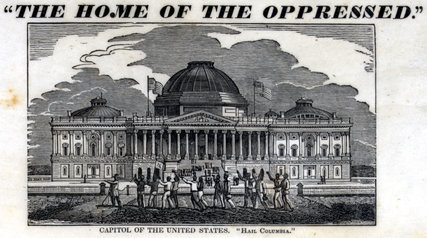12 Years a Slave, and the Capitol building
Last night, my daughter Faith and I went to see the movie 12 Years a Slave. It is a movie specifically about the experience of slavery before the Civil War. Though at least one character makes a remark on how this will all have to change someday, no one mentions the President, any bill in Congress, or any news of any kind. There are no scenes that follow the lives of non-slave characters. The focus is on the day-to-day experience of slavery.
That's what makes the movie powerful and almost intolerable. There is no escape, no opportunity for vengeance, not even any sign the system could ever possibly change. And, in fact, it didn't, until invading armies destroyed it.
It is even realistic in that we see privileged slaves: household slaves, and slave mistresses who have learned to take advantage of their position. And we do see one slave mistress who was finally sold off by her previous master's daughter, and is now a field hand like the rest, because a position that is only granted by someone else can just as easily be taken away.
There is actually one small opening out to imply the larger political situation, in a really brief image. After the freeborn Solomon Northup is kidnapped into slavery and chained in a cell, the camera pans up and reveals that his location is Washington DC. We know this because we see the Capitol Building on its hill.
And even here, the movie shows its quality, and its daring, because it shows the Capitol as it looked in the 1840s, with its low copper dome, not the 1863 building we all know. I can't find a screenshot from the film, but this shows the dome so you can see how low it was then:
 The original Capitol, with a coffle of slaves
The original Capitol, with a coffle of slaves
This is daring because the image lasts only a second or two, and most people will not instantly recognize that version of the building. Steven Spielberg's Amistad (1997), a movie about slaves and slave trading set in 1839 that focused mostly on the white characters, lacked that courage. There is a scene with John Quincy Adams where what looks like the post-1863 Capitol looms behind him.
In fact, what it shows is the c1900 Rhode Island State House:
 A great building by McKim, Mead and White, but not the U.S. CapitolWhen I saw the movie, though, I did not think we had moved to Providence. I saw it as the Capitol building.
A great building by McKim, Mead and White, but not the U.S. CapitolWhen I saw the movie, though, I did not think we had moved to Providence. I saw it as the Capitol building.
Filmakers and writers setting scenes in the past are always torn between being true to the situation, attitudes, look, language, and relationships as they really were, and making sure that those are comprehensible and sympathetic to a modern audience. I think this movie takes at least one step toward accuracy and away from comfort. I'm sure people will point out inaccuracies, and places it could have gone even farther. That's inevitable. It goes incredibly far.
This makes a great pairing with last year's Lincoln, white people arguing about slavery, because it shows what they were arguing about. And I will say, as I said about Lincoln, that every American should see it.